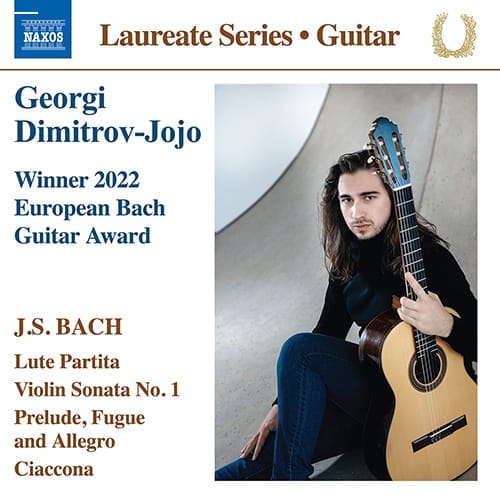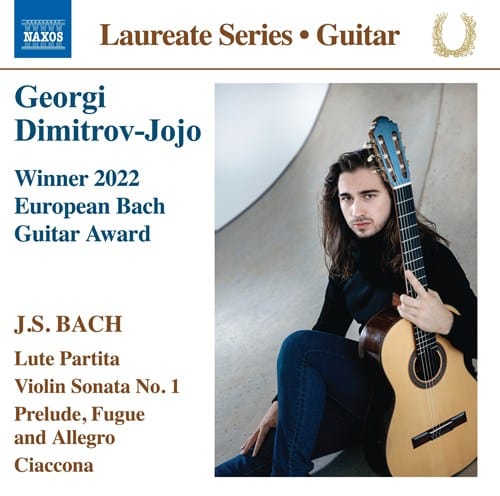The Bach CD, Concept and Thoughts on the Process


"Guitar Recital: Georgi Dimitrov-Jojo - J.S. BACH: Transcriptions for Guitar" - to be released on the 26th of April 2024. Available on all digital platforms now!
The repertoire I have recorded in this album portrays a great part of my exploration in the world of music during the years I spent in Graz under the guidance of my teacher and mentor, Paolo Pegoraro, to whom I would like to dedicate this album. He is the greatest influence on me and has a crucial role in my development as a musician. I would like this recording to remain a testimony to his teaching.
I was hoping that by using this opportunity given to me by the European Bach Guitar Award and Naxos I would be able, to my best ability, to tell a very personal story about my own absorption of the world and, therefore, my perception of the music of one of the greatest composers in history. I needed to perform Johann Sebastian Bach’s works in a way in which the final product of the recording would embody my own journey of discovering these masterpieces.
By recording the music of J. S. Bach, I had the chance to share with the public a very important part of my endeavors to fulfill a common dream of prof. Pegoraro and myself, to deliver something beyond the physical, a musical experience which could have the potential to engulf one’s mind, and soul and which is beyond the limitations of thought about matter, or instrument. For that to happen, I needed to change my approach to the guitar. I wanted to create a sonority that could recreate the richness and, if I may say, the humility that baroque instruments possess. My view is that the spontaneous movement of the phrasing has a natural closeness to the human nature, so much that it inspires the creativity within the one who performs it.
Therefore, some adjustments needed to be made in order to reduce the natural overtones of the guitar and to make it sound more “chamber”, and intimate.
For the entire recording the tuning is set at 426 Hz – a very low tuning that is not compatible with most modern instruments. I’m lucky that my guitar could allow it.
I was specific with the choice of flat tonalities – F Major (BWV1006a), G Minor (BWV1001) and Eb Major (BWV998), because of the lesser ability of the guitar to resonate, as opposed to sharp tonalities. Had I chosen keys that are more typical for my instrument (E Major, A Minor and D Major respectively), the result would have been much more “guitar- like”. The change of tonality of the E Major Lute Suite BWV1006a and the Prelude, Fugue and Allegro BWV998, arranged by Tilman Hoppstock, was accomplished with the use of a capo on the first fret, and I decided to use Maestro Manuel Barrueco’s arrangement of the Violin Sonata BWV1001, because he has preserved the original key, instead of choosing the more comfortable A Minor. The only tonality that I had no second thought about was that of the Ciaconna BWV1004 in D Minor, for which I used the arrangement of my teacher, Paolo Pegoraro, in which the listener can enjoy a tastefully balanced amount of additional voice lines to transcend the innate ability of the instrument to sound polyphonically rich and, yet, not flamboyant.
Over the years, in our interpretations of the music by J. S. Bach in this album, prof. Pegoraro and myself have implemented ornamentations and composed additional lines, influenced by the world of the historical baroque instruments (baroque lute, the harpsichord, the baroque violin etc.). In that way we wanted to bring the airy freshness, the creative spontaneousness this music portrays, as is documented in treatises on playing baroque music from composers and performers who lived during this period.
My intention was never to change the great works of Johann Sebastian Bach, but to rather retransform my instrument through research of sound quality, reduce of overtones and, to my best ability, baroque-like ingenuity, in order to travel away from voluminous tendencies of our modern days. It is my humble hope that to the ears of the listener these interpretations would get them as far away from physical thought, and deliver them to the timelessness of Bach’s music, which is full of hope, love and life.
I am honored to have been able to work with the amazing sound engineer Norbert Kraft, who created such a welcoming and inspirational atmosphere. The difficulty of recording an entire CD, moreover, with the music Bach was turned into a most pleasant experience, due to Norbert’s ability to build up a great working environment (sometimes also imitating the passing trains outside which stopped the recording process). I am grateful to him for his masterful captivation of the sound, his unbreakable professionalism and care for the final product.
I would like to dedicate this CD to one more great human. My dearest godfather, patron, an art endorser, a friend of my family, Bert Karel, who generously provided me with the instrument which you hear in this recording – a guitar made by the luthier Carsten Kobs.
In general, most of my interpretational decisions are founded on the idea of choosing an adequate key for each work, and in the following description I talk plenty about that. I was seeking an intimate and “unmodern” sonority. The first step towards that was to stray from the already successfully attempted arrangements-assimilations of Bach’s music by guitar masters before me. Lightness and unpretentiousness were my aim.
There are many opinions regarding the “Lute suites” and the instrument for which they were intended, since some of the pieces present such big challenges, they are unplayable on the baroque lute. The likeliest theory is that they were written for a keyboard instrument called Lautenwerck, made to imitate the sound of the lute, and we know that Bach owned two of that kind. However, the original key of the Lute Suite No. 4 BWV 1006a is E major, which makes it impossible to perform on a baroque lute. When transposed to E-flat major, the agility and virtuosity of this piece is closer to being accomplishable.
Aware of this key change, I allowed myself the liberty to transpose the suite in F major, to avoid the heaviness and the typical “guitar-like” sound of E major. In my opinion, that helps to fly off the ground and higher, as if reaching to God with the might of the Prelude, a praise to him for giving the living another day in this world.
I had a similar approach to the Prelude, Fugue and Allegro BWV998, which I am performing in the original key. I was taught to view this piece as a Hymn of Joy and Gratitude. The Fugue itself is one of the few that Bach wrote in da capo structure, and intertwined throughout the entire cycle, one can find the presence of motives from its theme in all three movements, symbolizing the unity and entity of this tryptich.
(Bach's da capo fugues are a perfect model for understanding the process of overlapping musical genres in the 18th century and as a means of illuminating the process of musical reflection with regards to personal preferences, transformation and the condensation of structure.)
The G minor Sonata for violin is one of the most technically challenging compositions in the catalogue of Bach’s music playable on the guitar. Its uncomfortable tonality gives the left hand no rest for majority of time. In the chaos of constant motion, the Siciliana invites a much more pastoral scenery, which creates the most secluded, solitary moment among those works. The calmness of this movement is a calm before the storm of the Presto. I owe a lot to Maestro Pegoraro and to Maestro Oscar Ghiglia for their enlightening insight.
“The more musicians in the world, the bigger the variety of interpretations” is applicable to any composition, but no piece matches the diversity of views of the Ciaconna BWV1004. I perform it in the French style of dotted notation, with a few ornamental enhancements, inspired by masters of the harpsichord like Robert Hill, Pierre Hantaï. The close relation of the harpsichord with plucked instruments enables more thought for additional polyphonic lines and filling tones within chords, making the sound more graceful and rich.
I will never claim that I hold the key to something with my opinion on that masterpiece, or any of Bach’s music. My only hope that the audience sees this record as a strive for justified, tasteful creativity.